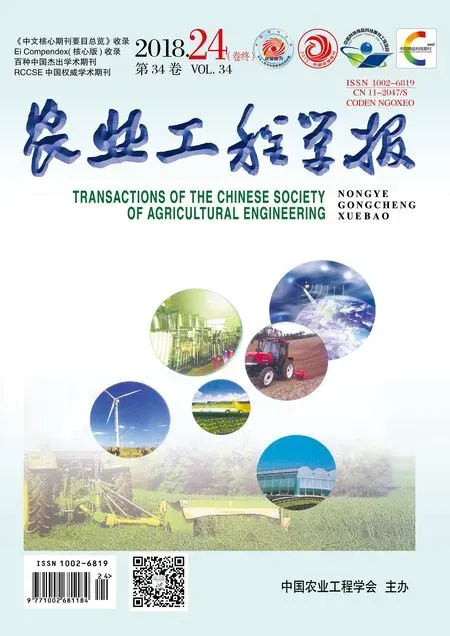通水间断时长对太阳能低温地板采暖系统供暖性能的影响
李金平,徐奥博,甄箫斐,黄娟娟,王春龙
通水间断时长对太阳能低温地板采暖系统供暖性能的影响
李金平,徐奥博,甄箫斐,黄娟娟,王春龙
(1.兰州理工大学西部能源与环境研究中心,兰州 730050;2. 甘肃省生物质能与太阳能互补供能系统重点实验室,兰州 730050;3. 西北低碳城镇支撑技术协同创新中心,兰州 730050;4. 兰州理工大学能源与动力工程学院,兰州 730050)
为了揭示供暖水泵通断模式对太阳能低温地板采暖系统供暖性能的影响,试验和理论研究了通水时长相同间断时长不同时系统的供回水温差变化规律,分析了系统的供热量、热损失率、运行能耗及太阳能保证率的变化,研究了供暖时系统内外因素与供热量的相关性,研究结果表明:太阳能采暖系统23 d不同通断模式的运行试验结果表明,环境条件相近及通水时长都为8 min时,间断时长越长,供回水温差越大;系统在3种通断模式下的供热量由高到低依次为间断6、5、11 min;间断6 min时比间断5 min时系统太阳能保证率增多5.27%,热损失率减少2.79%,运行能耗减少6.67%,对比可得间断6 min时系统运行较好;由23 d的运行效果可得,间断6 min时系统平均供热效率最高;室外温度、供水温度、回水温度、流量、风速等因素与供热量都有显著相关性,供水温度和环境温度对系统供热量影响较大,循环流量和环境风速的影响较小。
太阳能;供暖;温度;太阳能低温地板采暖系统;通断模式;太阳能保证率;供热量;运行能耗
0 引 言
中国农村地区经济条件普遍较差,冬季采暖多以薪柴和煤炭为主,采暖方式落后[1]。同时,中国大部分农村地区光照充足,利用太阳能采暖前景广阔。然而,一定集热面积的太阳能采暖系统集热量有限,提高集热量的利用效率成为提高系统性价比的关键。
国内外开展了许多太阳能采暖系统供暖性能的研究。一些学者研究了太阳能地板采暖系统的供回水温度、室内空气温度、地板换热量、热负荷等特性[2-5]。张淑贞[6]通过试验证明相变材料可显著提高系统的太阳能保证率。Kurtay 等[7]使用太阳能地板采暖系统给办公室供暖,室内舒适度较好。Verma等[8]通过改变质量流量提高太阳能辅助地源热泵系统的集热量和储热量。王亚辉等[9]对太阳能-天然气分户式供暖系统的研究表明太阳能热水系统与壁挂炉互补性强、运行稳定。Bahria等[10]通过模拟对太阳能供热制冷系统参数进行了优化。Forsström等[11]讨论了太阳能区域采暖系统的辅助能源成本最小化问题,适宜的辅助能源可节省供暖成本。Mazarrón等[12]研究了太阳能采暖系统的供水温度与年平均效率的关系,随着供水温度的增加,系统效率会降低。张志成[13]比较了太阳能空气采暖系统的几种运行策略,变风量的运行效率优于连续运行和间歇运行,变风量模式比连续定风量模式节能37%。Li等[14]根据不同的需热量、天气等条件提出了不同的太阳能采暖系统运行策略,旨在提高供热效率。另外,国内外许多研究发现通断模式对集中供暖系统性能有明显影响。李叶茂等[15]利用调节断水时间改变供热量,降低了热网回水温度。项翔坚等[16]设定通水时间为地板存水的置换时长,断水时间内利用存水继续供热,发现回水温度大幅降低。也有学者发现双参数通断控制可以提供较好的温度调节[17-18],控制电动阀的通断来调节供热可以提高能量利用率[19-20]。Liu等[21-22]利用智能通断阀保持和预测室温,室内温度保持在设定点0.5 ℃范围内,房间能耗减少约30%。Kuosa等[23]提出了1个调节质量流量的供热模式,该模式的流量是传统模式的46%。综上,在集中供暖系统,通断模式对采暖性能有明显影响,至今尚没有人研究通断时长对太阳能低温地板采暖系统性能的影响。
为此,本文研究了3种不同的通断供暖模式下太阳能采暖系统的供暖效果,为探究优化的供暖模式提供借鉴。
1 试 验
1.1 太阳能低温地板采暖系统简介
本文利用太阳能低温地板采暖系统对甘肃省民勤县张麻新村一户挤塑聚苯板保温的单层建筑供暖(图1、2)。供暖系统利用6组串联的全玻璃真空管太阳能集热器集热和储热,总集热面积约23.1 m2。每组集热器主要由40支58 mm×1 800 mm的真空管和1个400 L储热水箱组成,集热面积约3.85m2,集热器方位角为南偏西约40°,集热平面与水平面夹角45°。单层建筑平面图如图1所示,建筑面积约为117 m2,层高2.8 m,住宅面积约103 m2,利用低温地板采暖系统给1个客厅和3个卧室供暖。低温地板有4条地暖管回路,每个房间有1条回路。地暖盘管使用PE-RT管双回型布置,管径DN 20,管间距200 mm,距墙150 mm。铺设地暖时,先铺设40 mm厚聚苯乙烯泡沫板作为绝热层,然后铺设地暖盘管,盘管上方使用50 mm水泥砂浆填充,最后上方铺设8 mm厚地板砖。
1.2 系统通断时长的选择
2015年12月太阳能采暖系统在23 d内进行了不同通断模式的运行试验。由于供暖水泵的最短安全运行时间为5 min,因此供暖通水时长均设定为8 min。鉴于系统白天的集热量有限,环境温度较低时可能出现管路冻结,影响系统的正常使用。为了保证系统的安全可靠运行,间断时长应尽量短为好。试验研究了间断时长分别为5、11、6 min的系统供暖情况,系统的供暖时段设定为17:00-23:30。
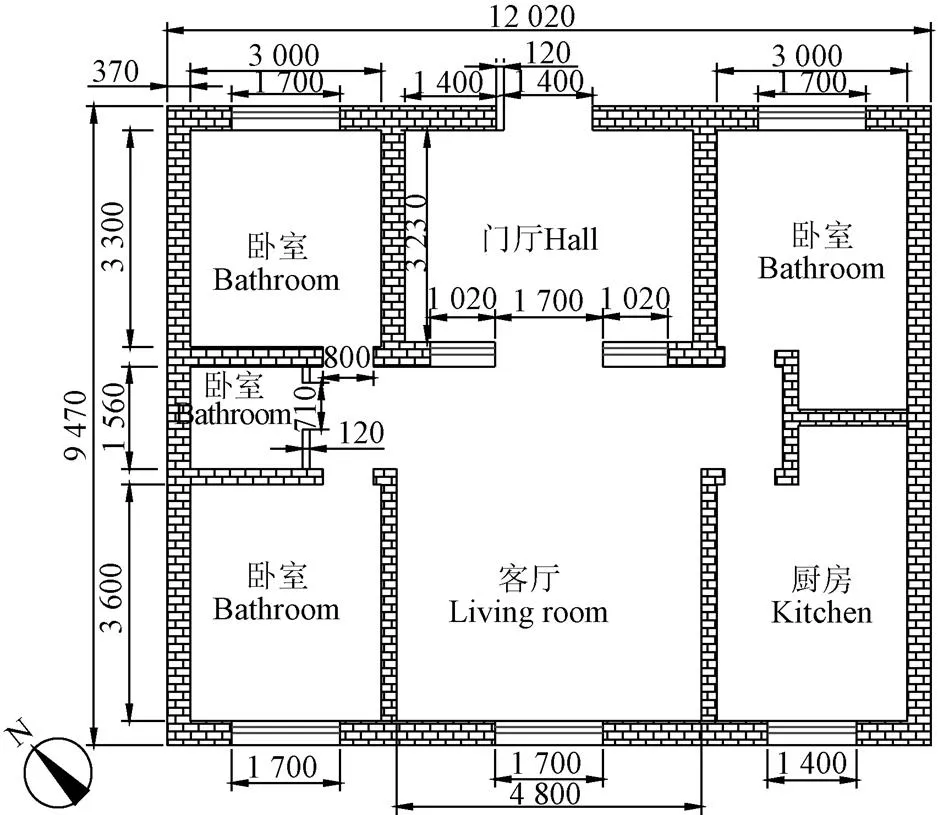
图1 建筑平面图

图2 太阳能采暖系统示意图
1.3 试验测试
本试验对太阳辐射强度、环境温度、环境风速、水箱温度、供回水温度、循环流量等参数进行了测量,主要测试仪器如下:
1)四线制Pt100温度传感器用来测试供回水温度、水箱内热水温度及环境温度,量程:−50~100 ℃,精度:A级,±0.15 ℃;
2)YGC-FS风速传感器用来测试环境风速,量程:0~45 m/s,精度:0.3 m/s;
3)TBQ-2总辐射表用来测试太阳辐射强度,灵敏度:8.963V/(W·m2),精度:2%;
4)LWGY-20涡轮流量计用来测试水泵流量,量程:0.7~7.0 m3/h;精度:±0.44%;
5)Agilent 34970A数据采集仪用来采集和记录相关测试数据,自动采集和记录时间间隔为10 s。
1.4 系统供热量影响因素分析方法
影响系统供热量的因素可以分为系统内部因素和外部因素。系统内部因素包括供水温度、回水温度、循环流量等,外部因素包括室外温度、风速等室外气象参数。
这里不讨论通断模式对系统供热量的影响,主要分析2015年12月25日17:00-23:30时间段的室外温度、供水温度、回水温度、流量、风速等因素与供热量的相关性,用相关系数判断各个因素与供热量的相关性大小。
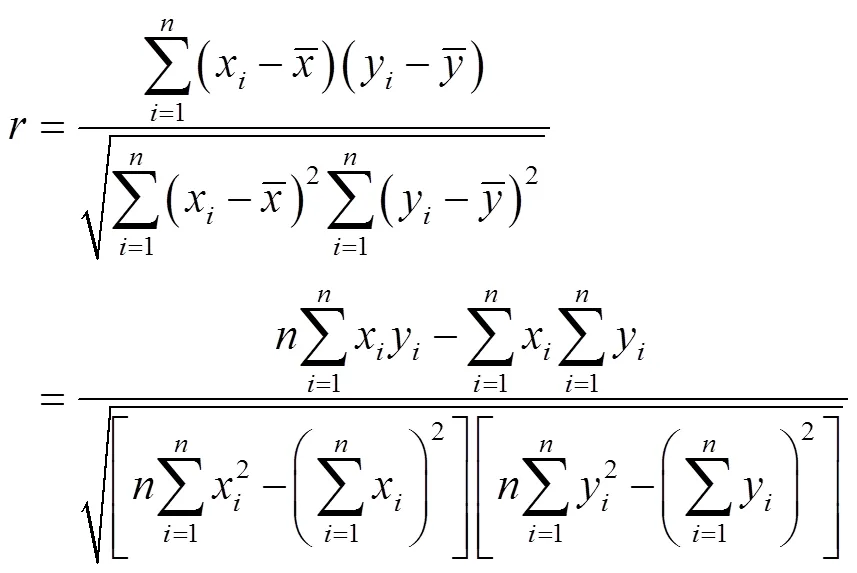


2 计算公式
在供暖期间,系统的内能变化量分成2部分,一部分散失到环境,一部分通过地板层供给房间。
2.1 系统静态热平衡方程式

式中Q为系统内能变化量,kW·h;Q为系统供热量,kW·h;Q为系统热损失量,kW·h。
系统内能变化量公式

式中为系统中热水的总质量,kg;c为水的比热容,J/(kg·℃);t为供暖开始时水箱的水温,℃;t为供暖结束时水箱的水温,℃。
供回水管路和地暖管中滞留热水和水箱储存热水相比较小,计算系统供暖期间总内能变化量时忽略不计。
系统供热量公式如下

式中为热水的质量流量,kg/s;t,t为通水时地暖管进出口水温,℃。这里近似认为集热器出口和进口水温等于地暖管进出口水温;Δ为通水时长,s。
2.2 系统热损失率
系统损失的热量占系统内能变化量的比值为系统的热损失率。在供暖期间的系统热损失率的计算公式

2.3 系统运行能耗分析
在本系统中,水泵是整个系统的动力部件和主要耗能设备。因此,认为系统的运行能耗主要是水泵的电能消耗。
系统的实耗功率[24]可由式(7)计算

式中P为水泵额定功率,W;PLR为使用热源的部分负荷比,即实际输出功率与额定输出功率的比值;、、为系数。
在简化计算法中,一般考虑以下3种常见情况:
1)水泵的负荷恒定,流量为常数(辐射供暖常用):=1,=0,=0;
2)水泵的负荷有变化:=0,=1,=0;
3)水泵的流量有变化:、、都不等于0。
按照情况1,系统运行能耗计算式如下:

式中为系统运行能耗,kJ;为水泵功率,本试验采用的水泵额定功率为120 W。
2.4 建筑耗热量
为了计算和对比3 d的太阳能保证率,这里计算3 d的建筑耗热量。建筑耗热量[25]的计算公式如下
Q
H
=
Q
HT
+
Q
INF
−
Q
IH
(9)
式中H为建筑物耗热量,W/m2;HT为围护结构的传热耗热量,W/m2;INF为空气渗透耗热量,W/m2;IH为建筑内部得热量,取3.8 W/m2[26]。
围护结构耗热量计算公式如下

式中t为室内空气计算温度,取14 ℃[27];t为室外平均温度,℃;为围护结构传热系数的修正系数;为围护结构传热系数,W/(m2·℃);为各个围护结构面积,m2。
冷风渗透耗热量计算公式如下

式中c为空气的定压比热容,取0.28 W/(kg·℃);为冬季室外平均温度下的空气密度,kg/m3;为换气次数,0.5次/h;为换气体积,m3/次。
2.5 太阳能保证率
太阳能保证率是评价太阳能采暖系统的重要指标[28]。系统每日的太阳能保证率计算公式如下

3 结果与分析
3.1 环境条件对比
为了减小环境因素对试验结果的影响,选择环境条件相近的3 d进行对比,3 d的太阳辐射强度基本一致,最大太阳辐射强度都出现在14:00左右(图3)。12月3日、25日、30日太阳辐射强度最大值分为886.7、881.8、880.7 W/m2,平均值分别为633、623.5、625.4 W/m2,全天日照时间分别为8.6、8.5、8.7 h。
12月3日、25日、30日环境最低温度分别为−8.5、−10.1、−8.9 ℃,平均温度分别为−3.1、−3.2、−2.3 ℃。对照组前一天即12月2日、24日、29日的环境平均温度分别为−2.3、−4、−3.3 ℃。
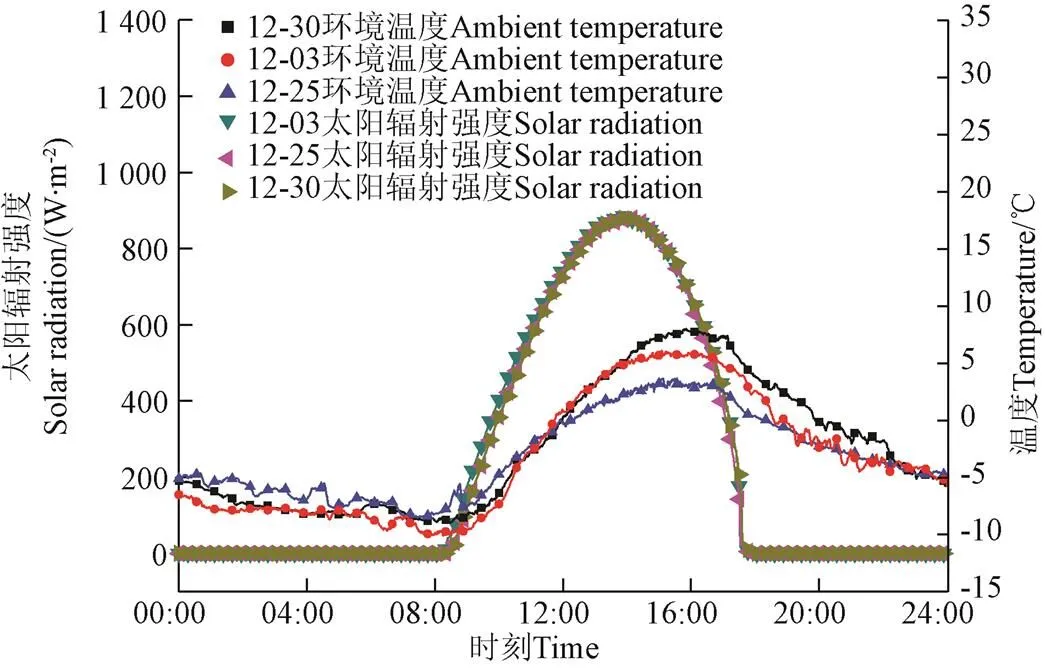
图3 环境条件对比
3.2 系统供暖效果分析
3.2.1 供回水温差对比
如图4所示,随供暖的持续进行,供回水温度阶跃变化逐渐下降。图4取自12月25日19:00-20:24。由于供回水温度测点在管路中靠近水箱进出口的位置,且供回水管路不是水平放置,间断时供水测点受环境影响较大,回水温度测点受水箱里的热水影响较大。通水开始时,供水温度先迅速上升,然后至水温基本稳定状态。通水结束后供水管温度快速下降,说明供水管路向环境散热很快。系统回水温度开始供暖时先下降后快速上升,因为热水滞留在管路,散热快温度下降较多,然后是滞留在地暖管中的热水进入水箱,地暖管中热水置换完成后,持续通水,回水温度回升至较平稳状态。
系统有效采暖面积为64 m2,按照每平方米地板铺设5 m地暖管路,计算得地暖管总长度为320 m。供回水管为DN32的铝塑管,系统通水时平均流量为0.27 kg/s。经计算得间断时地暖管中存水体积为0.1 m3,地暖管中热水置换时间为148 s小于通水时长8 min。因此,每次通水时有一段时间回水温度较高。
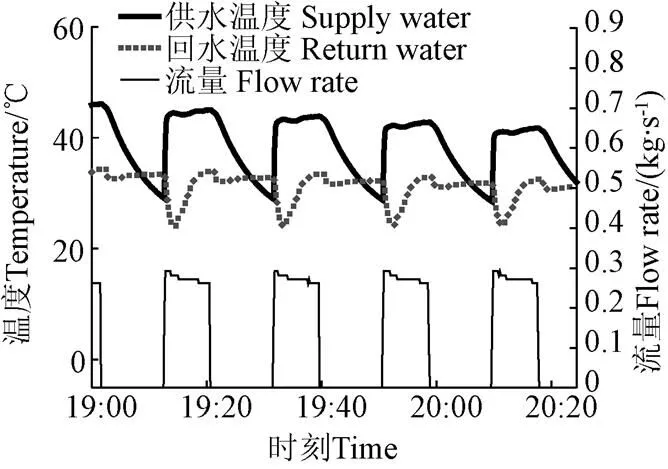
图4 12月25日太阳能采暖通断模式供回水温度示意图
由表1、图5可以看出,供暖开始到结束,3 d的水箱水温变化基本一样。由于供暖起始水温都是51 ℃左右,环境条件相近,因此可以认为供回水温差不同主要是因为供暖间断时长不同。间断11、6、5 min供回水温差平均值分别为13.5、11.5、10.7 ℃。间断时长越长,热水滞留在地暖管中的时间越长,供回水平均温差越大。

表1 供暖开始至结束水箱热水温度

图5 不同通断模式供回水温差对比
3.2.2 系统供暖性能对比
从表2可得:供暖时间段内,3 d的系统内能变化量基本相同。因此,供热量越多,系统热损失越少。由公式(5)计算得系统供热量如表3,间断6 min的系统供热量最多为47.61 kW·h,比间断5 min多供应4.7%的热量,间断11 min供热量最少。由公式(6)计算可得间断5、6、11 min系统热损失率分别为41.16%、38.37%、46.56%。
经计算得,在每日供暖期间,12月3日、25日、30日水泵启停次数分别为30、21、28次。每次水泵运行时间相同,间断时长越短,启停次数越多,系统运行能耗越高。由公式(8)计算得运行能耗如表2。12月3日建筑耗热量为60.15 kW·h,12月25日为60.56 kW·h,12月30日为58.88 kW·h。由于环境条件相近,3 d的建筑耗热量相差较小,供热量越多,太阳能保证率越高,太阳能保证率计算结果如表2。

表2 不同通断模式下的系统供暖性能对比
通过3 d的供暖效果对比可知:12月25日太阳能保证率最低,12月30日太阳能保证率比12月3日增多约5.27%,系统运行能耗比12月3日减少约6.67%,系统热损失率比12月3日减少约2.79 %。因此,环境条件相近,通水时长和供暖起始水温相同时,不是间断时长越长或短,系统供暖效果越好,间断时长太长,会导致热量不能有效地供给房间;间断时长太短,地暖管的热水没有足够的换热时间,回水温度过高,影响供热效率同时使得系统热损失增多。因此,合理的间断时长可以提高系统的供热效果。
3.2.3 系统运行分析
表3为采暖系统在2015年12月的不同通断模式运行结果。试验天数为23 d,12月3日、25日、30日的起始供暖水温约为51 ℃,12月4日、8日、29日的起始供暖水温约为50 ℃,12月5日、9日、26日的起始供暖水温约为48 ℃。供热效率是系统的有效输出的能量与输入的能量之比,对比不同通断模式的平均供热效率来说明不同模式的差异。由表3计算可得12月的同一运行模式的平均供热效率,间断5、6、11 min的平均供热效率分别为56.57%、61.08%、59.80%,因此,在起始供水温度分别约为51、50及48 ℃条件下,不同运行模式下的系统供热量不同,间断6 min的运行模式下系统的供热量较多,系统的供热效率较高。
3.3 系统供热量影响因素分析
这里不讨论通断模式对系统供热量的影响,主要分析2015年12月25日17:00-23:30时间段的室外温度、供水温度、回水温度、流量、风速等因素与供热量的相关性。相关性系数的正负表示二者呈正相关和负相关,绝对值越大,相关性越强。从表4可以看出,供水温度、室外温度与供热量的相关性较大,循环流量、风速与供热量的相关性较小。采用显著性水平来检验各个影响因素与供热量的显著性。在99 %的置信度也就是1 %的出错概率下,文献[29] “数值表”中值为2.576,表4各影响因素的绝对值均大于2.576,所以各个因素显著影响系统的供热量。由表4的各个影响因素的值可得,影响供热量的较大系统内部因素为供水温度,较大的外部因素为环境温度。

表3 不同运行模式的长期运行效果

表4 各因素与系统供热量的相关性分析
4 结 论
通过试验和理论分析,可得以下结论
1)采用通断模式可以增加热水在地暖管中停留时间,有效降低回水温度,提高供回水温差,减少管路的热损失,提高能源利用效率。因此,对于太阳能低温地板采暖系统,通断模式是一种较好的系统供热调节方式。
2)12月3日、25日、30日起始供水温度均为约51 ℃,间断时长分别为5、11、6 min,太阳能保证率分别为75.59%、68%、80.86%。可得12月30日供热量最多,太阳能保证率最大,比12月3日提高约5.27%,运行能耗节省6.67%,热损失率减少2.79%。由2015年12月的23 d试验可得,间断6 min的平均供热效率最高。因此,供暖起始水温相同,环境条件相近,通水时长一定时,存在最佳间断时长使得系统供热量最多,同时减少系统运行能耗和热损失。
3)通过相关性分析可得文中各因素对供热量都有显著相关性,影响系统供热量的最大内部因素为供水温度,供水温度越高,供热量越多;回水温度的相关系数小于供水温度,回水温度越低,供热量越大;最大外部影响因素为环境温度。循环流量和风速与供热量的相关性最小。
针对系统的供暖模式,提出优化建议如下:采用合适的间断时长,可以使高温热水得到足够与地板层接触和换热的时间,有效降低回水温度,减小回水管路热损失,增加系统的供热量,提高供热效率。
[1] 杨柳,赵云兵. 寒冷地区农村住宅冬季室内热环境研究[J].建筑节能,2013,41(7):2-7.
Yang Liu, Zhao Yunbing. Study on winter indoor thermal environment of rural houses in cold regions[J]. Building Energy Conservation, 2013, 41(7): 2-7. (in Chinese with English abstract)
[2] 张增. 太阳能地板辐射采暖系统工况特性研究[D]. 银川:宁夏大学,2014.
Zhang Zeng. Research on Working Conditions Characteristics of Solar Floor Radiant Heating System[D]. Yinchuan: Ningxia University, 2014. (in Chinese with English abstract)
[3] 孟二林,张奕,王子介,等. 太阳能地板辐射采暖系统在连续运行时的系统特性研究[J]. 太阳能学报,2011,32(9):1381-1386.
Meng Erlin, Zhang Yi, Wang Zijie, et al. Study on the system characteristics of solar floor radiant heating system in continuous operation[J]. Acta Energia Sinica, 2011, 32(9): 1381-1386. (in Chinese with English abstract)
[4] 熊安华,代彦军. 西藏地区太阳能低温热水采暖系统研究[J]. 建筑热能通风空调,2008(2):56-58,76.
Xiong Anhua, Dai Yanjun. Study on solar low temperature hot water heating system in Tibet[J]. Building Thermal Energy Ventilation and Air Conditioning, 2008(2): 56-58,76. (in Chinese with English abstract)
[5] 汪海涛. 主动式太阳能采暖间歇运行热负荷特性研究[D].西安:西安建筑科技大学,2010.
Wang Haitao. Study on the Thermal Load Characteristics of Active Solar Heating Intermittent Operation[D]. Xi’an: Xi’an University of Architecture and Technology, 2010. (in Chinese with English abstract)
[6] 张淑贞. 太阳能热水储热相变系统在住宅建筑中的高效利用研究[D]. 天津:天津大学,2017.
Zhang Shuzheng. Study on the Efficient use of Solar Hot Water Storage and Heat Phase Change System in Residential Buildings[D]. Tianjin: Tianjin University, 2017. (in Chinese with English abstract)
[7] Kurtay C, Atilgan I, Ataer O E. Performance of solar energy driven floor heating system[J].Thermal Sciences and Technology, 2009, 29(1): 37-44.
[8] Verma V, Murugesan K. Experimental study of solar energy storage and space heating using solar assisted ground source heat pump system for Indian climatic conditions[J]. Energy & Buildings, 2017, 139: 569-577.
[9] 王亚辉,田瑞,宋力,等. 太阳能―天然气分户式供暖系统的运行及节能效果[J]. 农业工程学报,2013,29(7):164-169.
Wang Yahui, Tian Rui, Song Li, et al. Operation and energy saving effect of solar-natural gas household heating system[J]. Transactions of the Chinese Society of Agricultural Engineering (Transactions of the CSAE), 2013, 29(7): 164−169.
[10] Bahria S, Amirat M, Hamidat A, et al. Parametric study of solar heating and cooling systems in different climates of Algeria: A comparison between conventional and high-energy-performance buildings [J]. Energy, 2016, 113: 521-535.
[11] Forsström J P, Lund P D. Optimization of operating strategies in a community solar heating system[J]. Applied Mathematical Modelling, 1985, 9(2):117-124.
[12] Mazarrón Fernando R, Porras-Prieto C J, García José Luis, et al. Feasibility of active solar water heating systems with evacuated tube collector at different operational water temperatures[J]. Energy Conversion and Management, 2016, 113: 16-26.
[13] 张志成. 太阳能空气采暖系统变流量运行策略优化方法研究[D].大连:大连理工大学,2010.
Zhang Zhicheng. Research on Optimization Method of Variable Flow Operation Strategy for Solar Air Heating System[D]. Dalian: Dalian University of Technology, 2010. (in Chinese with English abstract)
[14] Li W T, Thirugnanam K, Tushar W, et al. Improving the operation of solar water heating systems in green buildings via optimized control strategies[J]. IEEE Transactions on Industrial Informatics, 2018, 99: 1-1.
[15] 李叶茂,夏建军,江亿. 通过末端通断控制降低热网回水温度[J]. 区域供热,2015(4):45-49.
Li Yemao, Xia Jianjun, Jiang Yi. Reducing the temperature of the return water of the heating network through the end-off control[J]. District Heating, 2015(4): 45-49. (in Chinese with English abstract)
[16] 项翔坚,张涛,吴明洋,等. 混凝土辐射地板新型通断调节方法性能分析[J]. 暖通空调,2017,47(3):63-67.
Xiang Xiangjian, Zhang Tao, Wu Mingyang, et al. Performance analysis of new on-off regulation methods for concrete radiant floors[J]. HVAC, 2017, 47(3): 63-67. (in Chinese with English abstract)
[17] Cho S H, Zaheer-Uddin M. An experimental study of multiple parameter switching control for radiant floor heating systems[J]. Energy, 1999, 24(5): 433-444.
[18] Zaheeruddin S H. Temperature regulation of radiant floor heating systems using two-parameter on-off control: An experimental study[J]. ASHRAE Transactions, 1997, 15 (6): 205-217.
[19] 安晓英. 新型通断调节模式计量供热系统性能实验研究[D]. 天津:河北工业大学,2006.
An Xiaoying. Experimental Study on the Performance of a New On-off Regulation Mode Metering Heating System[D]. Tianjin:Hebei University of Technology, 2006. (in Chinese with English abstract)
[20] 方立德. 新型供热计量控制系统动态特性研究[D].天津:河北工业大学,2005.
Fang Lide. Research on Dynamic Characteristics of New Heating Metering Control System[D]. Tianjin: Hebei University of Technology, 2005. (in Chinese with English abstract)
[21] Liu L, Fu L, Jiang Y. A new “wireless on-off control” technique for adjusting and metering household heat in district heating system[J]. Applied Thermal Engineering, 2012, 36(1): 202-209.
[22] Liu L, Fu L, Jiang Y. An on-off regulation method by predicting the valve on-time ratio in district heating system[J]. Building Simulation, 2015, 8(6): 665-672.
[23] Kuosa M, Kontu K, Mäkilä T, et al. Static study of traditional and ring networks and the use of mass flow control in district heating applications[J].Applied Thermal Engineering, 2013, 54(2): 450-459.
[24] Knebel D E. Simplified Energy Analysis Using the Modified Bin Method[M]. Atlanta: America Society of Heating, Refrigeration and Air Conditioning Engineer Inc, 1983: 64-68.
[25] 太阳能供热采暖工程技术规范:GB50495-2009[S].
[26] 严寒和寒冷地区居住建筑节能设计标准:JGJ26-2010[S].
[27] 农村居住建筑节能设计标准:GB/T 50824-2013[S].
[28] 岑幻霞. 关于太阳能保证率的计算[J]. 太阳能学报,1981(1):59-68. Cen Huanxia. Calculation of the fraction “” of the heating load supplied by solar energy[J]. Acta Energiae Solaris Sinica, 1981(1): 59-68. (in Chinese with English abstract)
[29] Giblert M. Renewable and Efficient Electric Power Systems[M]. USA: Wiley & Sons, 2013(8): 55-62.
Effect of time interval of water-supply on heating performance of solar low temperature floor heating system
Li Jinping, Xu Aobo, Zhen Xiaofei, Huang Juanjuan, Wang Chunlong
(1.,,730050,; 2.730050,; 3.730050,; 4.730050)
In rural area of China, due to low income, it has been popularly used for winter-heating with straws and coal. The heating method is so backward that it is promising for heating with solar energy. Since the heat gain from sun is limited to specific area, it is essential to improve the efficiency of solar energy utilization. Some researchers found that on-off modes of circulating pump took obvious effects on heating performance of central heating. In this paper, three different kinds of on-off modes were applied to the solar floor heating system in order to discover the influence of on-off modes. The experiment was conducted during the winter in a single-storey building in Zhangma Village, Minqing county, Gansu province, China. The total area of the building is 117 m2, the residential area of about 103 m2, whose actual heating areas is 64 m2. The heating system consists of 6 sets of vacuum tube solar collectors. Each collector consists of 40 vacuum tubes in58 mm ×1 800 mm with a 400 L water tank. The heating period was 17:00-23:30 every day in Dec 2015. The system had the same water-flowing duration of 8 min and three different intermittent durations, 5 min intermittent durations on Dec 3th, 11 min on Dec 25th, and 6 min on Dec 30th. Various parameters, such as the solar radiation intensity, the supply and return temperature of the system, the tank temperature, the ambient temperature, the flow rate and the ambient wind speed, were all measured by various sensors in the experiment. All measured parameters were acquisited and recorded automatically by the Agilent 34970A every 10 s. The variation law of difference of supply and return temperature during the heating period was analyzed, the heat supply, heat loss rates, energy consumptions, the solar fractions and average heating efficiency of the system all were calculated, the correlations between various factors with the heat supply were analyzed. The experimental results reveal the following: With the same water-flowing durations, the longer the discontinuous time, the greater the difference of supply and return temperature. Compared with the time interval of 5 min, the solar fraction of the time interval of 6 min was increased by 5.27%, heat loss rate of the system decreased by 2.79%, and the operating energy consumption decreased by 6.67%. The time interval of 6 min had the highest average heating efficiency of the system in 3thto 29thin Dec 2015. Various factors discussed were significantly correlated with the heat supply. The supply temperature and the ambient temperature had greater impact on the heat supply, but the flow rate and the ambient wind speed had less impact on it. According to the operation modes of the solar floor heating system, the water-flowing time was longer than the displacing time of water stored in the pipes under the floor. Not only the water supply displaced the hot water in the pipes completely every time, but also there was some high temperature water flowing through the return pipe. In the further operation, the water-flowing time should be reduced, so that the water-flowing time could be equal to the displacing time of water in the pipes, and the high temperature water was prevented from losing excessive heat through the return pipe.
solar energy; heating; temperature; solar low temperature floor heating system; on-off modes; solar fraction; heat supply; operating energy consumption
李金平,徐奥博,甄箫斐,黄娟娟,王春龙. 通水间断时长对太阳能低温地板采暖系统供暖性能的影响[J]. 农业工程学报,2018,34(24):217-223. doi:10.11975/j.issn.1002-6819.2018.24.026 http://www.tcsae.org
Li Jinping, Xu Aobo, Zhen Xiaofei, Huang Juanjuan, Wang Chunlong. Effect of time intervalof water-supply on heating performance of solar low temperature floor heating system[J]. Transactions of the Chinese Society of Agricultural Engineering (Transactions of the CSAE), 2018, 34(24): 217-223. (in Chinese with English abstract) doi:10.11975/j.issn.1002-6819.2018.24.026 http://www.tcsae.org
2018-07-26
2018-10-10
国家重点研发计划课题(2018YFB0905104)、国家自然科学基金项目(51676094)、甘肃省国际科技合作专项项目(1604WKCA009)、兰州市人才创新创业项目(2017-RC-34)、甘肃省自然科学基金(1508RJZA051)
李金平,教授,博士,博士生导师,主要从事先进可再生能源系统方面的研究。Email:lijinping77@163.com
10.11975/j.issn.1002-6819.2018.24.026
TU832.1+2;S210.43
A
1002-6819(2018)-24-0217-07

